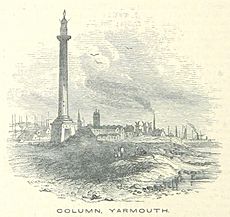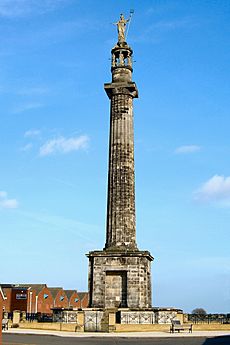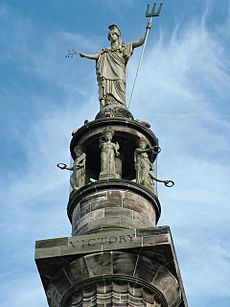Britannia Monument facts for kids
The Nelson's Monument is a tall column built to remember Admiral Horatio Nelson. He was a famous British naval hero. You can find this monument in Great Yarmouth, Norfolk, England. It was built a long time ago, between 1817 and 1819. Today, it is a very important historical building, known as a Grade I listed structure.
Contents
History of Nelson's Monument
A talented architect named William Wilkins designed this monument. Local important people helped raise the money to build it. It took about two years to finish.
The first person to look after the monument was James Sharman. He was a sailor from Norfolk. James was even part of the crew on Nelson's ship, HMS Victory. He was one of the people who carried Nelson below deck after he was shot in battle.
What the Monument Looks Like
The monument's official name is the Norfolk Naval Pillar. It looks like a classic Greek Doric column. On top, there are six figures called caryatids. These are statues of women that look like they are holding up the roof. They support a statue of Britannia. Britannia is a symbol of Britain. She stands proudly on a globe. On the globe, you can see Nelson's family motto: Palmam Qui Meruit Ferat. This means 'Let him who has earned it take the palm'. Britannia holds an olive branch in one hand and a trident in the other. She faces inland, supposedly towards Nelson's birthplace in Burnham Thorpe.
The whole monument is about 144 ft (44 m) tall. That's like a 14-story building! To reach the top, you have to climb about 217 steps.
Restoration and Location
The monument was fully repaired in 2005. This was just in time for the 200th anniversary of the Battle of Trafalgar. That was Nelson's most famous battle. In 2006, it was taken off a special list for buildings that were at risk of falling apart. Today, the monument stands in an industrial estate. It has its own small fenced-off area. You can visit the monument on certain days.
Over the years, parts of the monument have been replaced. The original figures were made of a special stone. Later, they were replaced with concrete copies. In 1982, the statue of Britannia and the six supporting figures were replaced with new ones made of fiberglass.
Remembering Nelson's Victories
At the bottom of the monument, there are special messages. They remember Nelson's four biggest victories against Britain's enemies, the French and Spanish. These battles were:
- The Nile (Aboukir), on August 1 and 2, 1798. Nelson was on HMS Vanguard.
- Copenhagen, on April 1, 1801. Nelson was on HMS Elephant.
- St Vincent, on February 14, 1797. Nelson was on HMS Captain.
- Trafalgar, on October 21, 1805. Nelson was on HMS Victory.
On the top part of the monument, you can find the names of four ships Nelson sailed on during these battles.
On the side that faces inland, there's a message in Latin. It says: "This great man Norfolk boasts her own, not only as born there of a respectable family, and as there having received his early education, but her own also in talents, manners and mind." This means that Norfolk is proud of Nelson. He was born there, grew up there, and had great skills and character.
Nelson's Monument in Art
There is a song called "Nelson's Monument" that talks about this famous column.
An Irish poet named George Croly also wrote a poem about the monument. It was called 'Nelson's Pillar'. He wrote it on the beach in Great Yarmouth during a stormy evening. The poem was first published in 1818.




